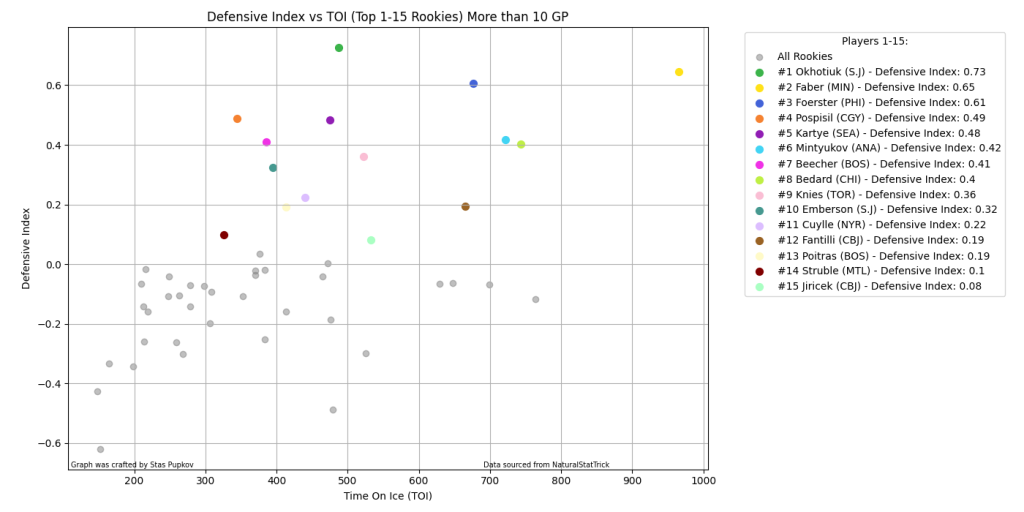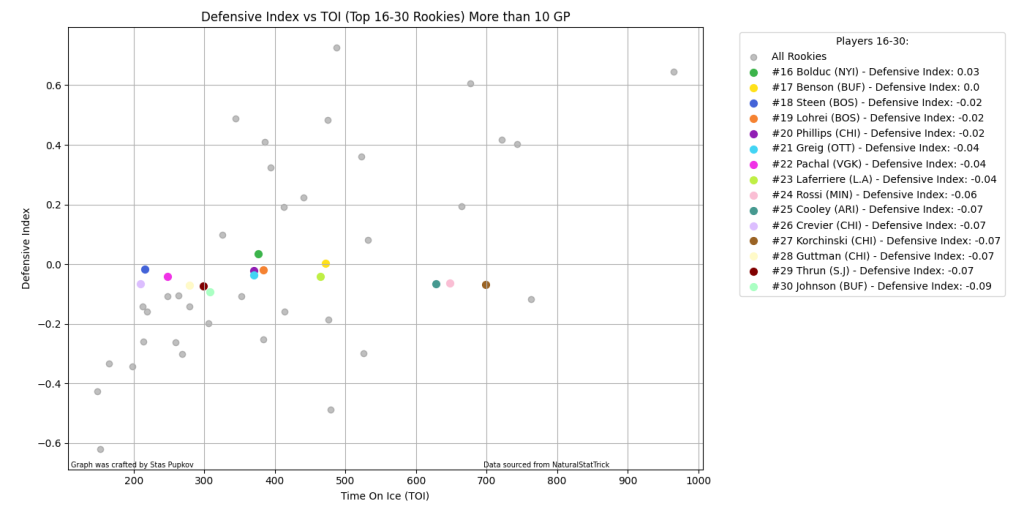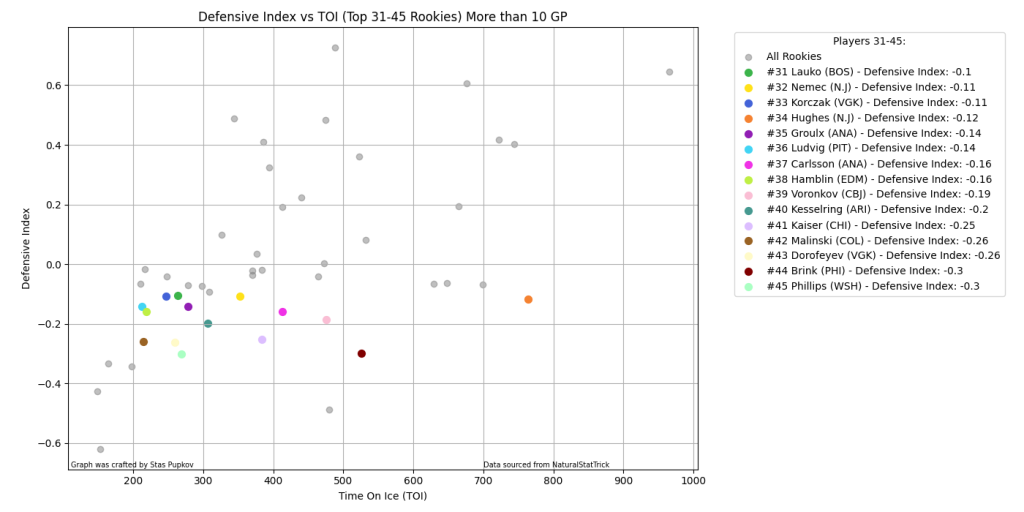As the new NHL season rolls out, the spotlight inevitably falls on the league’s rookies. These players are more than just new recruits; they’re catalysts of change, each with the potential to redefine the contours of the game. Our analysis forges ahead, tapping into a rich vein of advanced metrics to trace the rookies’ impact on their teams’ defensive prowess. We’re delving into a territory where the likes of Shots Blocked and Takeaways become the new currency, measuring the rookies’ contribution not in goals scored, but in goals prevented. In a sport where defense is as crucial as offense, this study aims to spotlight the rookies who are not merely playing – they are sculpting the game’s future with every shift.
Understanding the Defensive Index
In the quest to quantify the defensive prowess of the NHL’s newest entrants, the Defensive Index emerges as a pivotal analytical tool. This index is a composite score derived from a range of metrics, each chosen for its ability to encapsulate a facet of defensive performance. In this year’s cohort of rookies, we’ve leveraged Shots Blocked, representing the ability to disrupt opposition plays; Hits, a gauge of physical presence; and Takeaways, indicative of puck recovery skills. Conversely, metrics like Giveaways and Total Penalties serve as indicators of potential vulnerabilities on the ice. Together, these statistics form the backbone of our Defensive Index, offering a multifaceted view that traditional stats like goals and assists can overlook. By emphasizing these aspects, we aim to illuminate the rookies who excel not just in offensive flurries but in the nuanced art of defense.
Our methodology for assessing the defensive contributions of NHL rookies is both rigorous and multi-dimensional. It begins with a curated dataset, encompassing a comprehensive range of statistics, each serving as a puzzle piece in the broader image of a player’s defensive game. To ensure an equitable analysis, we normalize the data using Z-scores—a statistical technique that measures a value’s relationship to the mean within a group of values. This standardization process neutralizes the variances, allowing us to compare rookies on an even playing field, regardless of the number of games played or minutes on ice.
Each defensive action, from the stalwart blocking of shots to the finesse of executing a takeaway, is weighted according to its impact on the game. These weights are not arbitrary; they are thoughtfully calibrated to reflect the defensive significance of each action within the broader context of the game. A blocked shot, for instance, not only prevents a potential goal but also signifies a willingness to engage in play disruption, warranting its 20% weight in our index. Hits are valued at 17.5%, balancing the equation between physical assertiveness and tactical play.
Subtracting from the overall defensive score are giveaways and total penalties, metrics that, while part of the game, signal lapses in defensive judgment. A giveaway isn’t just a lost opportunity—it’s a potential counterattack, and as such, it carries a negative weight in our Defensive Index.
In sum, our methodical approach combines these weighted metrics to produce a Defensive Index that transcends traditional statistics, offering a more profound insight into each rookie’s ability to contribute defensively. This comprehensive index serves as the foundation for our subsequent analysis, paving the way for a nuanced understanding of rookie defensive performance.



Analysis
When we look at the rookies in the league, we see all kinds of defensive skills. Some are great at blocking shots, while others are really good at stealing the puck (takeaways). But mistakes happen too. If a player often gives the puck away or gets a lot of penalties, that’s not great for defense, and our index reflects that by lowering their score.
So, we looked at all these stats together, gave them each a fair weight, and got a score that tells us who the best defensive rookies are. It’s not just about how many games they play; it’s about what they do in those games that counts. Our analysis aims to highlight the rookies who are strong on defense, which is just as important as scoring goals.
In the detailed visual analysis of the Defensive Index across three distinct groups of rookies, each graph offers unique insights:
Top 1-15 Rookies – This graph is a showcase of the best rookie defenders. Here, the correlation between ice time and defensive prowess is strongest. Players in this group are not only reliable in their defensive roles but also show consistency and effectiveness in various game situations.
Top 16-30 Rookies – This mid-tier group is where potential meets variability. The rookies here display a spectrum of defensive skills. Some are close to breaking into the top tier, showing flashes of defensive brilliance, while others are steady contributors. The graph in this segment reveals the balancing act between gaining experience and showcasing defensive capabilities.
Top 31-45 Rookies – The rookies in this group represent the developmental aspect of the league. Their defensive play, while promising, indicates areas for growth. This graph is crucial for identifying players who, with time and experience, could significantly improve their defensive impact. It highlights the learning curve, and the journey of adaptation rookies undergo in the NHL.
Each graph is not just a representation of data but a narrative about growth, potential, and the different paths rookies take in their defensive roles in the NHL.
Conclusion
Our journey through the defensive landscapes of NHL rookies culminates here. The Defensive Index, a meticulous blend of critical metrics, has illuminated the unseen aspects of these players’ contributions. From the promising talents in the top 15 to the developing skills in the 31-45 range, we’ve seen a spectrum of defensive capabilities. This analysis not only spotlights the current standouts but also hints at the potential growth for others. As the season progresses, these rookies will continue to evolve, and our index will be a key tool in tracking their journey, offering insights into who might emerge as the future defensive stalwarts of the NHL.





 SEA
SEA CHI
CHI OTT
OTT EDM
EDM DAL
DAL STL
STL L.A
L.A ANA
ANA FLA
FLA CBJ
CBJ
